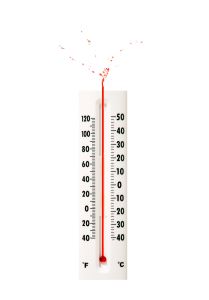
Source: Richard Newstead / Getty
Meteorologist are calling for another HOT day in the area. A heat advisory is in effect for most of NC with indexes in our areas reaching between 104 to 109.
Use caution against the heat.
Read more at WRAL.com
Symptoms
Heatstroke symptoms include:
- High body temperature. A body temperature of 104 F (40 C) or higher is the main sign of heatstroke.
- Altered mental state or behavior. Confusion, agitation, slurred speech, irritability, delirium, seizures and coma can all result from heatstroke.
- Alteration in sweating. In heatstroke brought on by hot weather, your skin will feel hot and dry to the touch. However, in heatstroke brought on by strenuous exercise, your skin may feel moist.
- Nausea and vomiting. You may feel sick to your stomach or vomit.
- Flushed skin. Your skin may turn red as your body temperature increases.
- Rapid breathing. Your breathing may become rapid and shallow.
- Racing heart rate. Your pulse may significantly increase because heat stress places a tremendous burden on your heart to help cool your body.
- Headache. Your head may throb.
When to see a doctor
If you think a person may be experiencing heatstroke, seek immediate medical help. Call 911 or your local emergency services number.
Take immediate action to cool the overheated person while waiting for emergency treatment.
- Get the person into shade or indoors.
- Remove excess clothing.
- Cool the person with whatever means available — put in a cool tub of water or a cool shower, spray with a garden hose, sponge with cool water, fan while misting with cool water, or place ice packs or cold, wet towels on the person’s head, neck, armpits and groin.
Ways to “beat the heat”
Avoid the Heat. Stay out of the heat and indoors as much as possible. Spend time in an air conditioned space. Only two hours a day in an air-conditioned space can significantly reduce the risk of heat-related illness. Shopping malls offer relief if your home is not air-conditioned. If air conditioning is not available, stay on the lowest floor out of the sunshine. Remember, electric fans do not cool, they just blow hot air around.
Dress for the heat. Wear loose-fitting clothes that cover as much skin as possible. Lightweight, light-colored clothing that reflects heat and sunlight and helps maintain normal body temperature. Protect your face and head by wearing a wide-brimmed hat. Avoid too much sunshine. Sunburn slows the skin’s ability to cool itself. Use a sunscreen lotion with a high SPF (sun protection factor) rating.
Drink FOR the Heat. Drink plenty of water and natural juices, even if you don’t feel thirsty. Even under moderately strenuous outdoor activity, the rate your body can absorb fluids is less than the rate it loses water due to perspiration. However, if you have epilepsy or heart, kidney, or liver disease; are on fluid-restrictive diets; or have a problem with fluid retention should consult a doctor before increasing liquid intake.
Do not drink IN the Heat. Avoid alcoholic beverages and beverages with caffeine, such as coffee, tea, and cola. Alcohol and caffeine constrict blood vessels near the skin reducing the amount of heat the body can release. Although beer and alcohol beverages appear to satisfy thirst, they actually cause further body dehydration.
Eat for the Heat. Eat small meals more often. Avoid foods that are high in protein because they increase metabolic heat. Avoid using salt tablets, unless directed to do so by a physician.
Living in the Heat. Slow down. Reduce, eliminate, or reschedule strenuous activities such as running, biking and lawn care work when it heats up. The best times for such activities are during early morning and late evening hours. Take cool baths or showers and use cool, wet towels.
Learn the symptoms of heat disorders and know how to give first aid.
Thinking About Others
Do not leave children in a closed vehicle, even for a few minutes. This is a “No-Brainer”. Temperatures inside a closed vehicle can reach 140°F-190°F degrees within 30 minutes on a hot, sunny day. However, despite this common sense rule, deaths from heat occur almost every summer when someone leaves their child in a closed vehicle.
When outdoors, protect small children from the sun, their skin is sensitive.
Help your pets keep their cool. It will “feel” as hot for them as it will for you. As with children, do not leave your pets in a closed vehicle. Be sure your animals have access to shade and a water bowl full of cold, clean water. Dogs don’t tolerate heat well because they don’t sweat. Their bodies get hot and stay hot. During summer heat, avoid outdoor games or jogging with your pet. If you would not walk across hot, sun-baked asphalt barefoot, don’t make your dog walk on it either. (Dogs can also get blisters on their paws from hot pavement.)
Learn the symptoms of heat disorders and know how to give first aid.
Source: National Park Service















